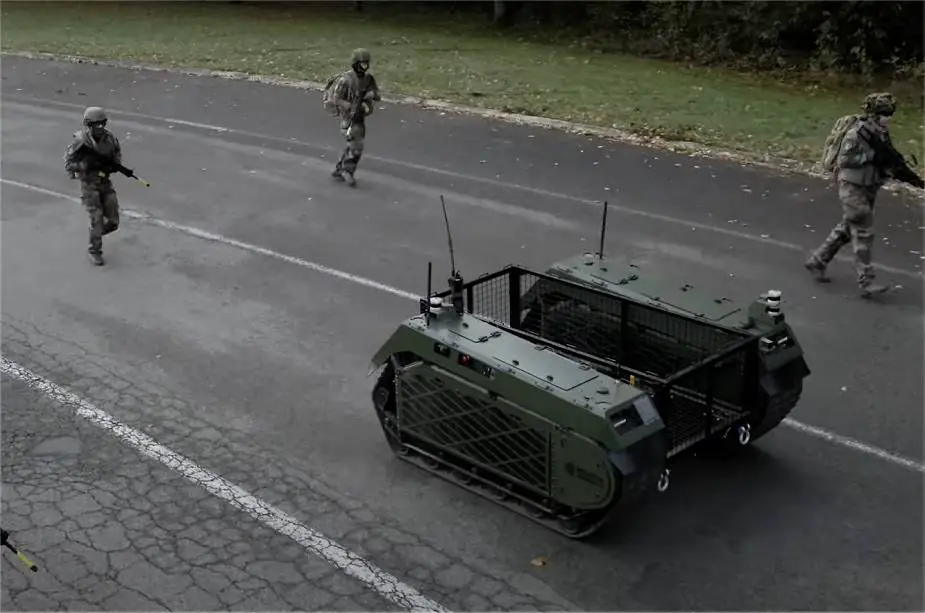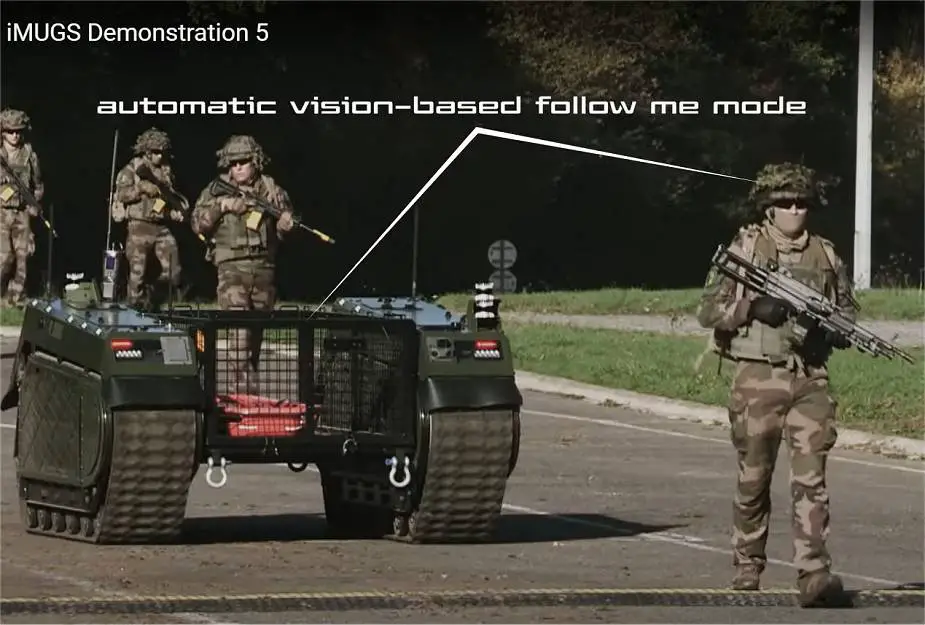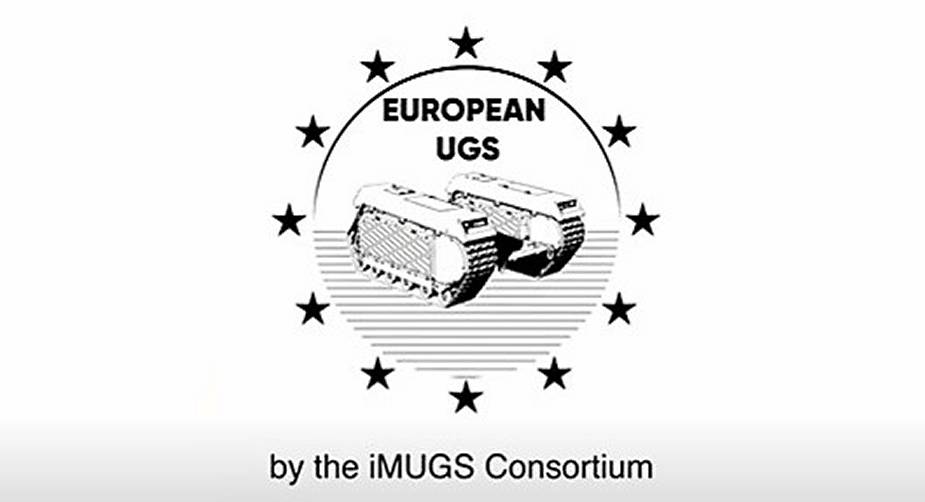The integrated Modular Unmanned Ground System (iMUGS) project Consortium showcased the usage of autonomous unmanned ground systems for various defence missions, including intelligence gathering, casualty evacuation and last mile re-supply at the project's penultimate demonstration in Versailles, France. Another demonstration was also conducted in Belgium. The event was led by Safran and Nexter and supported by other consortium members. All the partners met on the premises of Nexter Robotics, made available during the weeks of integration and validation preceding the demonstration.
Follow Army Recognition on Google News at this link

During the demonstration, three Milrem Robotics' THeMIS UGVs equipped with payloads from the consortium members and cooperation partners fulfilled several autonomous missions to demonstrate the ability of the complete iMUGS system (Picture source: screenshot from iMUGS video)
During the demonstration, three Milrem Robotics' THeMIS UGVs equipped with payloads from the consortium members and cooperation partners fulfilled several autonomous missions to demonstrate the ability of the complete iMUGS system. These included autonomous mission planning from the operator's point of view, ISR (Intelligence, Surveillance & Reconnaissance) with object detection and recognition, autonomous re-supply and casualty evacuation and cyber threat response.
The missions, performed by the French armed forces, presented how manned units can utilize unmanned systems to conduct missions more safely and effectively. "Unmanned systems increase stand-off distance from the enemy and, thanks to various sensors and effectors, provide soldiers the means to gather a higher quantity and much more precise information about their operation area than humans are capable of," said Kuldar Väärsi, CEO of Milrem Robotics, the iMUGS Consortium lead. "Autonomous unmanned assets are a game changer for armed forces as they allow the allocation of soldiers to more important tasks," Väärsi added.
The UGV's autonomous functionality that includes follow-me, waypoint navigation and obstacle detection and avoidance capabilities was developed by consortium members Diehl Defence, Milrem Robotics, Nexter and Safran. ISR was provided by OTEOS, Escribano Mechanical & Engineering's Electro Optic System, SAAB Grintek's Laser Warning System (LWS) and Metravib Defence's PEARL acoustic shot detection. Radio communication was provided by Bittium's software-defined radios.
The command and control (C2) and tactical C2ISR by GMV and sol.one were setup in the Krauss-Maffei Wegmann's Boxer Armoured Personnel Carrier (APC) with a C2 mission module and a static command centre. Cyber threat response was provided by Talgen. dotOcean and Insta showcased, via video, global and local swarming capabilities, respectively, in their in-house simulator.
The demonstration organized in France was the fifth of a total of six demonstrations held during the iMUGS project. The previous demonstrations were held in Estonia, Latvia, Finland, and Belgium. The last will be held in December in Germany.

The UGV's autonomous functionality that includes follow-me, waypoint navigation and obstacle detection and avoidance capabilities was developed by consortium members Diehl Defence, Milrem Robotics, Nexter and Safran. (Picture source: screenshot from iMUGS video)
The iMUGS Consortium previously demonstrated swarming missions with multiple robotic systems in Belgium
The iMUGS (integrated Modular Unmanned Ground System) project consortium showcased the use of swarm unmanned ground systems for defense missions such as reconnaissance, mapping and resupply during the project's fourth demonstration in the military camp of Marche-en -Famenne, Belgium. The event was led by the Royal Military School of Belgium (RMA) and supported by the other members of the consortium. All the partners met at Camp Roi Albert of the Belgian army, made available during the weeks of integration and validation preceding the demonstration.
During the demonstration, three Milrem Robotics THeMIS UGVs equipped with payloads from consortium members and cooperating partners completed several military missions in conjunction with swarms of smaller “winger” robotic systems to demonstrate the capabilities of the complete iMUGS system. These swarms of smaller robotic systems included a team of five “Kenny” robots from partner dotOcean which were used to map the terrain and provide a common operational picture of the battlespace and, alongside, a team of five “ Summit” from the RMA partner for autonomous replenishment operations. In order to underline the potential of the iMUGS solution in terms of crewed and unmanned teamwork, the missions were carried out in close collaboration with soldiers from the Belgian armed forces. The demonstration organized in Belgium was the fourth of a total of six demonstrations organized within the framework of the iMUGS project.
iMUGS project
iMUGS is a 32,6 MEUR project, a 13-party collaboration focused on developing a modular and scalable architecture for hybrid manned-unmanned systems. The parties involved are Milrem Robotics (project coordinator), Bittium, Diehl Defence, dotOcean, GMV Aerospace and Defence, Insta Advance, Krauss-Maffei Wegmann (KMW), Latvijas Mobilais Telefons (LMT), Nexter Systems, the Royal Military Academy of Belgium, Safran Electronics & Defense, Talgen Cybersecurity, and sol.one.
The aim of the project is to standardize a European-wide ecosystem for aerial and ground platforms, command, control, and communication equipment, sensors, payloads, and algorithms. The project addresses challenges such as enhanced interoperability, increased situational awareness, and faster decision-making.

















